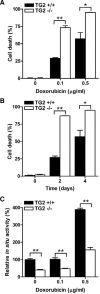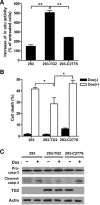Doxorubicin induces the persistent activation of intracellular transglutaminase 2 that protects from cell death
- PMID: 22382681
- PMCID: PMC3887707
- DOI: 10.1007/s10059-012-2201-9
Doxorubicin induces the persistent activation of intracellular transglutaminase 2 that protects from cell death
Abstract
The activation of transglutaminase 2 (TG2), an enzyme that catalyzes post-translational modifications of proteins, has been implicated in apoptosis, cell adhesion and inflammatory responses. We previously reported that intracellular TG2 is activated under oxidative stress conditions, such as ultraviolet irradiation, ischemia-reperfusion, and hypoxia. In this study, we examined the effect of genotoxic stress on the intracellular activity of TG2 using doxorubicin which generates reactive oxygen species that lead to double-strand breakage of DNA. We demonstrated that doxorubicin elicits the persistent activation of TG2. Doxorubicin-induced TG2 activity was suppressed by treatment with caffeine at the early phase, N-acetylcysteine at the mid-phase, and EGTA at the late phase. However, treatment with a blocking antibody against TGFβ or toll-like receptor 2 showed no effect on TG2 activity, indicating that at least three different signaling pathways may be involved in the process of TG2 activation. In addition, using MEF cells defective for TG2 and cells overexpressing an activesite mutant of TG2, we revealed that doxorubicin-induced cell death is inversely correlated with TG2 activity. Our findings indicate that the persistent activation of TG2 by doxorubicin contributes to cell survival, suggesting that the mechanism-based inhibition of TG2 may be a novel strategy to prevent drug-resistance in doxorubicin treatment.
Figures




Similar articles
-
The transglutaminase 2 gene is aberrantly hypermethylated in glioma.J Neurooncol. 2011 Feb;101(3):429-40. doi: 10.1007/s11060-010-0277-7. Epub 2010 Jul 3. J Neurooncol. 2011. PMID: 20596752 Free PMC article.
-
Functional characterization of naturally occurring transglutaminase 2 mutants implicated in early-onset type 2 diabetes.J Mol Endocrinol. 2012 Apr 2;48(3):203-16. doi: 10.1530/JME-11-0064. Print 2012 Jun. J Mol Endocrinol. 2012. PMID: 22394545
-
Transglutaminase 2 suppresses apoptosis by modulating caspase 3 and NF-kappaB activity in hypoxic tumor cells.Oncogene. 2010 Jan 21;29(3):356-67. doi: 10.1038/onc.2009.342. Epub 2009 Oct 19. Oncogene. 2010. PMID: 19838207
-
Transglutaminase-2: evolution from pedestrian protein to a promising therapeutic target.Amino Acids. 2017 Mar;49(3):425-439. doi: 10.1007/s00726-016-2320-2. Epub 2016 Aug 25. Amino Acids. 2017. PMID: 27562794 Review.
-
Tissue transglutaminase-mediated chemoresistance in cancer cells.Drug Resist Updat. 2007 Aug-Oct;10(4-5):144-51. doi: 10.1016/j.drup.2007.06.002. Epub 2007 Jul 27. Drug Resist Updat. 2007. PMID: 17662645 Review.
Cited by
-
Silencing of TGM2 reverses epithelial to mesenchymal transition and modulates the chemosensitivity of breast cancer to docetaxel.Exp Ther Med. 2015 Oct;10(4):1413-1418. doi: 10.3892/etm.2015.2679. Epub 2015 Aug 12. Exp Ther Med. 2015. PMID: 26622499 Free PMC article.
-
Intracellular construction of topology-controlled polypeptide nanostructures with diverse biological functions.Nat Commun. 2017 Nov 2;8(1):1276. doi: 10.1038/s41467-017-01296-8. Nat Commun. 2017. PMID: 29097677 Free PMC article.
-
Competitive Binding of Magnesium to Calcium Binding Sites Reciprocally Regulates Transamidase and GTP Hydrolysis Activity of Transglutaminase 2.Int J Mol Sci. 2020 Jan 25;21(3):791. doi: 10.3390/ijms21030791. Int J Mol Sci. 2020. PMID: 31991788 Free PMC article.
-
Transglutaminase-2 Is Involved in All-Trans Retinoic Acid-Induced Invasion and Matrix Metalloproteinases Expression of SH-SY5Y Neuroblastoma Cells via NF-κB Pathway.Biomol Ther (Seoul). 2012 May;20(3):286-92. doi: 10.4062/biomolther.2012.20.3.286. Biomol Ther (Seoul). 2012. PMID: 24130925 Free PMC article.
-
Transglutaminase 2 mediates hypoxia-induced selective mRNA translation via polyamination of 4EBPs.Life Sci Alliance. 2020 Feb 19;3(3):e201900565. doi: 10.26508/lsa.201900565. Print 2020 Mar. Life Sci Alliance. 2020. PMID: 32075852 Free PMC article.
References
-
- Antonyak M.A., McNeill C.J., Wakshlag J.J., Boehm J.E., Cerione R.A. Activation of the Ras-ERK pathway inhibits retinoic acid-induced stimulation of tissue transglutaminase expression in NIH3T3 cells. J. Biol. Chem. 2003;278:15859–15866. - PubMed
-
- Antonyak M.A., Miller A.M., Jansen J.M., Boehm J.E., Balkman C.E., Wakshlag J.J., Page R.L., Cerione R.A. Augmentation of tissue transglutaminase expression and activation by epidermal growth factor inhibit doxorubicin-induced apoptosis in human breast cancer cells. J. Biol. Chem. 2004;279:41461–41467. - PubMed
-
- Arai M., Yoguchi A., Takizawa T., Yokoyama T., Kanda T., Kurabayashi M., Nagai R. Mechanism of doxorubicin-induced inhibition of sarcoplasmic reticulum Ca2+-ATPase gene transcription. Circ. Res. 2000;86:8–14. - PubMed
-
- Boehm J.E., Singh U., Combs C., Antonyak M.A., Cerione R.A. Tissue transglutaminase protects against apoptosis by modifying the tumor suppressor protein p110 Rb. J. Biol. Chem. 2002;277:20127–20130. - PubMed
-
- Dalton T.P., Shertzer H.G., Puga A. Regulation of gene expression by reactive oxygen. Annu. Rev. Pharmacol. Toxicol. 1999;39:67–101. - PubMed
Publication types
MeSH terms
Substances
LinkOut - more resources
Full Text Sources

